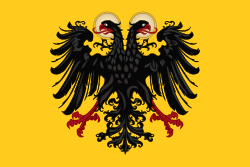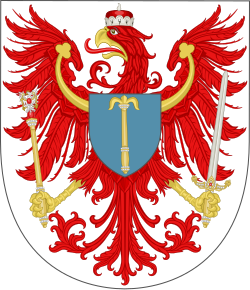Württemberské kurfiřtství
| Württemberské kurfiřtství Kurfürstentum Württemberg
| |||||||
Geografie
| |||||||
| Obyvatelstvo | |||||||
švábská němčina | |||||||
| Státní útvar | |||||||
monarchie | |||||||
| Státní útvary a území | |||||||
| |||||||
Württemberské kurfiřtství (německy Kurfürstentum Württemberg) byl krátce v letech 1803–1806 stát Svaté říše římské, který náležel do Švábského kraje. Na kurfiřtství bylo stávající Württemberské vévodství povýšeno francouzským císařem Napoleonem. Po zániku Svaté říše římské roku 1806 se kurfiřt prohlásil králem a Württembersko se stalo královstvím.
Reference
V tomto článku byl použit překlad textu z článku Electorate of Württemberg na anglické Wikipedii.
Související články
Externí odkazy
Média použitá na této stránce
Flag of the Kingdom of Württemberg; Ratio (3:5)
Autor: David Liuzzo, eagle by N3MO, Licence: CC BY-SA 3.0
Banner of the Holy Roman Empire, double headed eagle with halos (1400-1806)
Autor: Ziegelbrenner, Licence: CC BY-SA 3.0
Coats of arms of the electorate of Salzburg. 1+2: prince archbishop of Salzburg; 3. prince-bishop of Eichstätt; 4. prince-bishop of Passau; 5. prince-provost of Berchtesgaden; middle: 1 Old-Hungary; 2. New-Hungary; 3: Bohemia; 4: county of Tirol; 5: grand-duchy of Tuscany; 5: duchy of Lorraine; 5: county of Habsburg; heart: Austria
Coat of arms of Baden, Markgrafschaft
Autor: Samhanin, Licence: CC BY-SA 3.0
Coat of arms of the Electorate of Württemberg (1803-1806) 1.duchy of Teck; 2: principality of Ellwangen; 3: county of Mömpelgard; 4: lordship of Justingen; 5: county of Limpurg (Schenken von Limpurg) (The Limpurg Hills (German: Limpurger Berge) are a hill range, up to 564.7 m above sea level (NHN),[1] in the Swabian-Franconian Forest in the counties of Schwäbisch Hall and Ostalbkreis in the German state of Baden-Württemberg. The majority of the region belonged formerly to Limpurg Land owned by the family of Schenken von Limpurg, whose name was derived from their family home, Limpurg Castle near Schwäbisch Hall.); 6: lordship of Heidenheim; 7: lordship of Bönnigheim; 8a: Altdorf?; 8b: Esslingen or Heilbronn? 8c; Mindelheim? heart a: duchy of Württemberg; heartb: Reichssturmfahne. Inescutcheon is backwards and thus ahistorical.
Autor: Adelbrecht and Heralder, elements by Sodacan, Licence: CC BY-SA 3.0
Shield of Arms of the Arch-Marshal of the Holy Roman Empire.
Gold crown
Autor: Gundan, + my own edits, Licence: CC BY-SA 4.0
I principati elettorali del Sacro Romano Impero nel 1618
Autor: Ad17minstral, Licence: CC BY-SA 4.0
Arms of electoral Württemberg augmented with heraldic insignia of the imperial office of the Banner-bearer.
Autor: Ad17minstral, Licence: CC BY-SA 4.0
Silver Bohemian lion presenting a crown symbolizing the imperial crown of the Holy Roman Empire presented by the Arch Cupbearer—the King of Bohemia—at imperial coronations. Restored from hand-drawn Medieval armorials.
Autor: Adelbrecht and Heralder, elements by Sodacan, Licence: CC BY-SA 3.0
Shield of Arms of the Arch-Treasurer of the Holy Roman Empire.
Autor: ziegelbrenner, Licence: CC BY 2.5
Württemberg Anfang des 19. Jahrhunderts/Wuerttemberg at the beginning of the 19th century
Autor: Glasshouse, Licence: CC BY-SA 4.0
Shield of the Prussian State of Brandenburg
Autor: Adelbrecht and Heralder, elements by Sodacan, Licence: CC BY-SA 3.0
Shield of Arms of the Arch-Steward of the Holy Roman Empire.
Banner of the Arms of the Duchy of Württemberg.
Autor: MostEpic, Licence: CC BY-SA 4.0
Shield of Arms of the Arch-Bannerbearer of the Holy Roman Empire.
Autor: Ipankonin, Licence: CC BY-SA 3.0
Coat of arms of the Archbishopric of Mainz
Blazon: Gules a wheel with six spokes argent.Autor: MostEpic, Licence: CC BY-SA 4.0
Coat of arms of the house of Hesse-Kassel
Autor: Adelbrecht and Heralder, elements by Sodacan, Licence: CC BY-SA 3.0
Ancient Shield of Arms of the Arch-Chamberlain of the Holy Roman Empire.
Autor: ชาวไทย, Licence: CC BY-SA 4.0
Coat of Arms of Electorate of Cologne and the Archdiocese of Cologne.
Autor:
- Royal_Arms_of_the_Kingdom_of_Hanover.svg: Sodacan
- derivative work: Sodacan (talk)
Royal Shield of Arms of the Kingdom of Hanover































